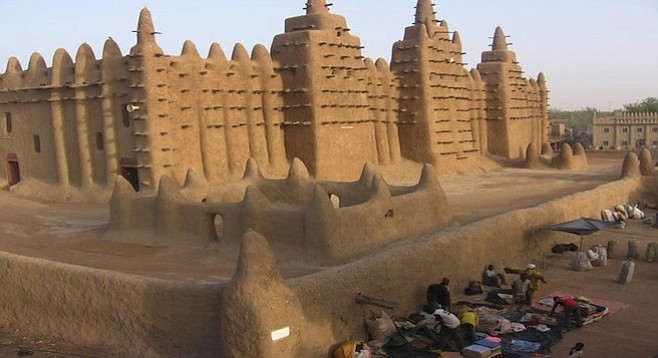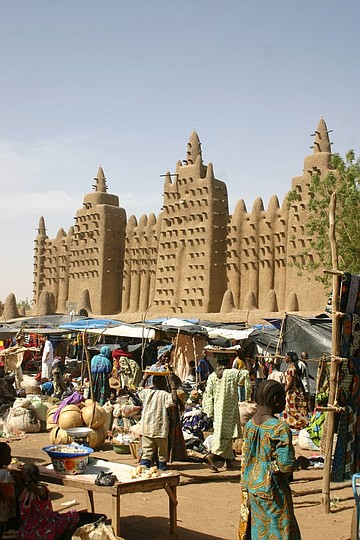 Facebook
Facebook
 X
X
 Instagram
Instagram
 TikTok
TikTok
 Youtube
Youtube

When the first rays of sunrise strike the great mosque at Djenné, many believers fall to their knees from its beauty.
Djenné, Mali, is a fly speck on a map. Overlooked by most travelers, it's at once a haven to bandits, smugglers, soldiers of fortune, and a photographer's dream. It is a long-gone part of Africa that will not return – a historical remnant whose stories wash away with its mud walls every monsoon season.
The grand mosque dominates the city. It is the largest mud building on earth, celebrating both Sudanese and French architecture favored by West African Islamic peoples of the Sahel and Sahara. It's been a UNESCO World Heritage Site since 1988, and until a pilgrim lays eyes on it, there is no way to describe how how it captures the soul.
Djenné was founded around 800 A.D. by nomad merchants on the site of an earlier settlement dating back to about 250 B.C. It was a gathering place for the caravan traders on routes coming out of the Sahara and Sudan, thriving because of its proximity to the Niger River that linked it to Timbuktu, a clearing house for those hauling gold, salt and slaves. For 180 years it was under Moroccan control, but was conquered by the French in 1893 when its commercial functions were transferred to the nearby port city of Mopti. For the next 81 years it was under the administration of the Foreign Legion.
It has long been a center of Islamic learning, where under sharia law theft is punishable by cutting off the right hand, and adultery is an offense that can get you stoned to death in a public square. Scourging is reserved for more minor offenses. In this part of the Sahara, blood feuds are common and disputes are often settled with knives.

A weekly market takes place in the square in front of the mosque, which turns into a churning sea of people under the blistering desert sun. Blue-turbaned Berbers mingle with leather-hatted Fulani nomads. Sunburnt trekkers in shorts wander among herds of sheep and cattle as exotic aromas and a hundred different languages drift on the air.
Today's mosque, made of sundried mud bricks, rises from the low mud bricks of Djenné like a massive mothership. Centered as it is among tiny private homes, it appears more like an apparition than a place of worship. Its one concession to the modern world is an automated audio system that calls the faithful to prayer with a digital recording.
The giant walls are studded with wooden beams protruding through to the outside. These aren't just ornamental: When the rains come annually, much of the building is washed away. In an annual week-long festival, the entire village climbs on these wooden beams to re-plaster the building's exterior.
Like most mosques the world over, it was open to everyone, until 1996, when it shut its doors to non-Muslims forever.
At that time, French Vogue magazine secured the permission of local Imams for a photo shoot within the mosque. Such events were not uncommon, and many of the worlds’ most beautiful mosques have been the subject of print stories.
Perhaps it was the sheer isolation of Djenné or just naiveté on the part of local religious leaders who had never seen a copy of Vogue, but they were not prepared for the onslaught of leggy young women in negligees with their Galois cigarettes and lunch fueled by French wine. Looking back today, one might ask Vogue editors, "What were you thinking?"
Recent calls to their French offices will only confirm that copies of that issue are no longer available, and no one wished to comment on it.
Written accounts are hard to come by today even with the Internet, and most of this story came from locals for whom this has become a folk legend. Resident Muslims still roll their eyes and shake their fists at the references to that day, while the non-Islamic population will tell you it was one of the most exciting things to hit the city in a century. As a former French colony, they refer to that day as the "Second French Invasion.”
My final night in the city, I met a young man in a dark corner of a local coffee house. In exchange for a few American dollars he told me conspiratorially that right after the blasphemous event, word went out from the Imams that anyone who spoke about it would suffer the full brunt of sharia law.
Today, the great Djenné mosque remains closed to “non-believers,” and some locals get belligerent when a camera is pointed in their direction. But even with its interior forever off-limits, the Djenné mosque remains an architectural wonder and one of the most beautiful buildings in the world.


When the first rays of sunrise strike the great mosque at Djenné, many believers fall to their knees from its beauty.
Djenné, Mali, is a fly speck on a map. Overlooked by most travelers, it's at once a haven to bandits, smugglers, soldiers of fortune, and a photographer's dream. It is a long-gone part of Africa that will not return – a historical remnant whose stories wash away with its mud walls every monsoon season.
The grand mosque dominates the city. It is the largest mud building on earth, celebrating both Sudanese and French architecture favored by West African Islamic peoples of the Sahel and Sahara. It's been a UNESCO World Heritage Site since 1988, and until a pilgrim lays eyes on it, there is no way to describe how how it captures the soul.
Djenné was founded around 800 A.D. by nomad merchants on the site of an earlier settlement dating back to about 250 B.C. It was a gathering place for the caravan traders on routes coming out of the Sahara and Sudan, thriving because of its proximity to the Niger River that linked it to Timbuktu, a clearing house for those hauling gold, salt and slaves. For 180 years it was under Moroccan control, but was conquered by the French in 1893 when its commercial functions were transferred to the nearby port city of Mopti. For the next 81 years it was under the administration of the Foreign Legion.
It has long been a center of Islamic learning, where under sharia law theft is punishable by cutting off the right hand, and adultery is an offense that can get you stoned to death in a public square. Scourging is reserved for more minor offenses. In this part of the Sahara, blood feuds are common and disputes are often settled with knives.

A weekly market takes place in the square in front of the mosque, which turns into a churning sea of people under the blistering desert sun. Blue-turbaned Berbers mingle with leather-hatted Fulani nomads. Sunburnt trekkers in shorts wander among herds of sheep and cattle as exotic aromas and a hundred different languages drift on the air.
Today's mosque, made of sundried mud bricks, rises from the low mud bricks of Djenné like a massive mothership. Centered as it is among tiny private homes, it appears more like an apparition than a place of worship. Its one concession to the modern world is an automated audio system that calls the faithful to prayer with a digital recording.
The giant walls are studded with wooden beams protruding through to the outside. These aren't just ornamental: When the rains come annually, much of the building is washed away. In an annual week-long festival, the entire village climbs on these wooden beams to re-plaster the building's exterior.
Like most mosques the world over, it was open to everyone, until 1996, when it shut its doors to non-Muslims forever.
At that time, French Vogue magazine secured the permission of local Imams for a photo shoot within the mosque. Such events were not uncommon, and many of the worlds’ most beautiful mosques have been the subject of print stories.
Perhaps it was the sheer isolation of Djenné or just naiveté on the part of local religious leaders who had never seen a copy of Vogue, but they were not prepared for the onslaught of leggy young women in negligees with their Galois cigarettes and lunch fueled by French wine. Looking back today, one might ask Vogue editors, "What were you thinking?"
Recent calls to their French offices will only confirm that copies of that issue are no longer available, and no one wished to comment on it.
Written accounts are hard to come by today even with the Internet, and most of this story came from locals for whom this has become a folk legend. Resident Muslims still roll their eyes and shake their fists at the references to that day, while the non-Islamic population will tell you it was one of the most exciting things to hit the city in a century. As a former French colony, they refer to that day as the "Second French Invasion.”
My final night in the city, I met a young man in a dark corner of a local coffee house. In exchange for a few American dollars he told me conspiratorially that right after the blasphemous event, word went out from the Imams that anyone who spoke about it would suffer the full brunt of sharia law.
Today, the great Djenné mosque remains closed to “non-believers,” and some locals get belligerent when a camera is pointed in their direction. But even with its interior forever off-limits, the Djenné mosque remains an architectural wonder and one of the most beautiful buildings in the world.
Comments